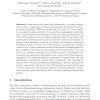Free Online Productivity Tools
i2Speak
i2Symbol
i2OCR
iTex2Img
iWeb2Print
iWeb2Shot
i2Type
iPdf2Split
iPdf2Merge
i2Bopomofo
i2Arabic
i2Style
i2Image
i2PDF
iLatex2Rtf
Sci2ools
106
Voted
MICCAI
2009
Springer
2009
Springer
Interventional 4-D Motion Estimation and Reconstruction of Cardiac Vasculature without Motion Periodicity Assumption
Abstract. Anatomical and functional information of cardiac vasculature is a key component of future developments in the field of interventional cardiology. With the technology of C-arm CT it is possible to reconstruct intraprocedural 3-D images from angiographic projection data. Current approaches attempt to add the temporal dimension (4D) by ECG-gating in order to distinct physical states of the heart. This model assumes that the heart motion is periodic. However, frequently arrhytmic heart signals are observed in a clinical environment. In addition breathing motion can still occur. We present a reconstruction method based on a 4-D time-continuous motion field which is parameterized by the acquisition time and not the quasi-periodic heart phase. The output of our method is twofold. It provides a motion compensated 3-D reconstruction (anatomic information) and a motion field (functional information). In a physical phantom experiment a vessel of size 3.08 mm undergoing a non-periodic mo...
Addition Breathing Motion | Heart Motion | Medical Imaging | MICCAI 2009 | Time-continuous Motion Field |
| Added | 06 Nov 2009 |
| Updated | 08 Dec 2009 |
| Type | Conference |
| Year | 2009 |
| Where | MICCAI |
| Authors | Christopher Rohkohl, Günter Lauritsch, Marcus Prümmer, Joachim Hornegger |
Comments (0)

